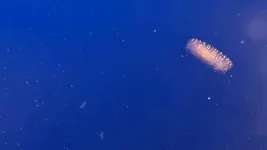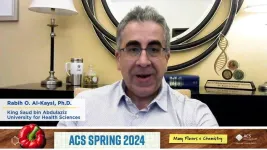(Press-News.org) A huge fraction of global flows of carbon and other nutrients passes through marine microbes, little is known about their causes of death—information that in many cases determines where those nutrients will go. Recent work on microbial death via viral lysis and protistan predation is helping close the gap, but there remains a missing source of microbial mortality. Anne Thompson and colleagues explore the role played by salps, pelagic tunicates that feed by pumping seawater through mucous mesh nets, filtering out and capturing particles such as preferred microbes. Salps send the carbon in microbes to the deep sea as sinking fecal pellets—or to predators of salps such as seabirds and sea turtles. The authors conducted SCUBA dives to characterize salp predation in the vast oligotrophic North Pacific Subtropical Gyre, an area dominated by small-cell microbes, especially the very small Prochlorococcus. The authors collected live salps (Pegea confoederata and Salpa maxima) and quantified the clearance rates for different microbial prey types. They also used quantitative PCR to compare the guts of Pegea confoederata to seawater. Despite the dominance of Prochlorococcus in seawater, microbes of that type were not found in higher concentrations in salps. Instead, salp guts were rich with Crocosphaera, Synechococcus, diatoms, and Chrysochromulina. Given the shapes and sizes of these taxa, the authors argue that simple mechanical principles—particle size, mesh dimensions or flow rates through the mesh— are not sufficient to explain cell capture by salps. According to the authors, salps play a major role in controlling the abundances and function of microbial communities in the vast nutrient-poor open ocean, with global implications.
END
Characterizing salps as predators of marine microbes
2024-03-19
ELSE PRESS RELEASES FROM THIS DATE:
Four PPPL researchers featured in the Physics of Plasmas Early Career Collection
2024-03-19
The U.S. Department of Energy’s Princeton Plasma Physics Laboratory (PPPL) made a strong showing in this year’s Early Career Collection from the scientific journal Physics of Plasmas. The collection represents the top papers from all areas of plasma physics research authored by people who defended their dissertations less than five years before the journal article was submitted.
“The first authors of the pieces in the 2023 Early Career Collection have made a notable contribution to the field of plasma and show significant promise. I look forward to ...
Does AI help or hurt human radiologists’ performance? It depends on the doctor
2024-03-19
One of the most touted promises of medical artificial intelligence tools is their ability to augment human clinicians’ performance by helping them interpret images such as X-rays and CT scans with greater precision to make more accurate diagnoses.
But the benefits of using AI tools on image interpretation appear to vary from clinician to clinician, according to new research led by investigators at Harvard Medical School, working with colleagues at MIT and Stanford.
The study findings suggest that individual clinician differences shape the interaction between human ...
Scientists identify Achilles heel of lung cancer protein
2024-03-19
Researchers have shown for the first time that a crucial interface in a protein that drives cancer growth could act as a target for more effective treatments.
The study was led by the Science and Technology Facilities Council (STFC) Central Laser Facility (CLF) and used advanced laser imaging techniques to identify structural details of a mutated protein which help it to evade drugs that target it.
It is published (19/03/2024) in the journal, Nature Communications and lays the groundwork for future research into ...
Insulin affects the recycling of cellular power plants
2024-03-19
The hormone insulin controls many cellular processes and adapts them to the body’s current energy supply. One of the insulin-regulated processes is the quality control of cellular power plants in neurons, Angelika Harbauer and her team at the Max Planck Institute for Biological Intelligence discovered. When sufficient energy is available in the body, insulin facilitates the elimination of defective mitochondria. When energy is scarce or when the insulin signal is interrupted, mitochondrial recycling is reduced and cells continue to use their old power plants, even potentially damaged ones. The continued operation of faulty mitochondria could affect ageing ...
Brown researchers develop brain-inspired wireless system to gather data from salt-sized sensors
2024-03-19
PROVIDENCE, R.I. [Brown University] — Tiny chips may equal a big breakthrough for a team of scientists led by Brown University engineers.
Writing in Nature Electronics, the research team describes a novel approach for a wireless communication network that can efficiently transmit, receive and decode data from thousands of microelectronic chips that are each no larger than a grain of salt.
The sensor network is designed so the chips can be implanted into the body or integrated into wearable devices. Each submillimeter-sized silicon sensor mimics ...
New research highlights strong demand for data on personalized risk of preeclampsia
2024-03-19
South San Francisco, Calif. (March 19, 2024) - A new study in BMC Pregnancy and Childbirth finds that objective information about risk of preeclampsia could be key to driving patient behavior change and creates motivation among pregnant patients to follow provider recommendations on prevention, even among those who are medication-hesitant.
Key findings include:
91% of the study participants desired predictive testing for preeclampsia
94% reported they would want blood pressure monitoring at home if found to be at high risk
88% reported they would be more motivated to follow their provider’s medication recommendations if at high risk. This finding was consistent ...
Toxic metal particles can be present in cannabis vapes even before the first use
2024-03-19
NEW ORLEANS, March 19, 2024 — Vapes have often been heralded as a “safer” way to consume either nicotine or cannabis, where legal to do so. But the devices present their own suite of risks that are slowly being revealed as they undergo increasing research and regulation. Now, researchers have discovered that nano-sized toxic metal particles may be present in cannabis vaping liquids even before the vaping device is heated, and the effect is worse in unregulated products.
The researchers will present their results today at the spring meeting of the American Chemical Society (ACS). ACS Spring 2024 is a hybrid meeting being held virtually and in person March ...
Is food waste the key to sustainable, plastic-free diapers and sanitary pads?
2024-03-19
NEW ORLEANS, March 19, 2024 — Once thrown away, disposable items such as diapers and sanitary pads can take hundreds of years to decompose, because their absorbent parts and waterproof layers contain plastics and other synthetic polymers. But now, researchers are replacing these materials with porous components made from protein biomass that is often discarded by the food and agricultural industries. These components are sustainable and biodegradable, and could potentially allow future diapers and sanitary pads to be flushed down a toilet or used as ...
Molecular crystal motors move like microbes when exposed to light
2024-03-19
NEW ORLEANS, March 19, 2024 — At first glance, Rabih O. Al-Kaysi’s molecular motors look like the microscopic worms you’d see in a drop of pond water. But these wriggling ribbons are not alive; they’re devices made from crystallized molecules that perform coordinated movements when exposed to light. With continued development, Al-Kaysi and colleagues say, their tiny machines could be used by physicians as drug-delivery robots or engineered into arrays that direct the flow of water around submarines.
The ...
Conversations in an MR scanner provides a novel view of the brain’s language network
2024-03-19
Researchers have revealed new insights into how the brain processes speech and listening during conversations through advanced investigations using functional magnetic resonance imaging (fMRI). In a groundbreaking study published in the esteemed journal Cerebral Cortex, researchers compared brain activity in individuals while both speaking and listening during natural conversational situations.
Conversational interactions are central to the everyday human experience. During conversation, we use language, together with social, and other cognitive skills to flexibly switch between the roles of speaker and listener. In research on ...








